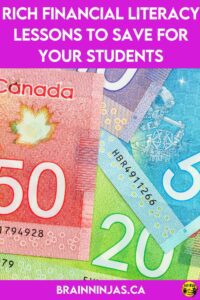
Gone are the days when parents would teach their kids how to use their money. In fact, many adults don’t know how to use their own money. According to a recent poll in Canada, seven of ten adults consider themselves financially literate. However, nearly 65% of Canadians admit to being in debt or living from one paycheck to another. So, what does it really mean to be financially literate, and what does this have to do with elementary education?
Being financially literate means having the knowledge, skills, and confidence to make responsible financial decisions. These days, that means knowing how to earn money, budget, save, and invest. The cost of living is significantly higher than in past generations, and wages have not kept up with the rate of inflation. That means it’s more important than ever for everyone to be financially literate. Simply making enough money is only part of the issue.
Financial literacy skills are commonly taught in math, but there are skills that can be used in any subject area. Being able to handle money correctly can impact a person’s mental and physical health. It is more important than ever that students understand how money works. Not only will this help them as a life skill, but hopefully, it will prevent them from becoming victims of fraud, which could take away their hard-earned money.
We have Financial Literacy units with detailed lesson plans aligned to the new Alberta Wellness curriculum for Grades 1-3 and Grades 4-6. There is more information at the end of this post.
Start With Money
Bills and Coins
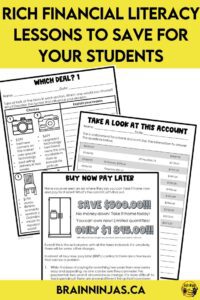
Since most people do not carry cash anymore, it can be tricky to teach kids to count change. A classroom isn’t a conducive setting to bring in wads of cash so students can practice. One way is with paper or plastic money. Buying yourself a set of clip art coins or copying some off of the internet means you can manipulate them in a variety of ways. This website https://toytheater.com/coins-canada/ has the correct denominations, but the pictures aren’t on the coins.
Practice counting coins and bills and learning the names. Count up the combinations and ask questions like how much more or how much would you get back if (making change)?
If you have the stamina to create an economy in your classroom, students can “purchase” items. This can help them count and make change.
Visit the Bank of Canada to look at bills and coins from throughout history. Challenge your students to find the most interesting ones.
Counting Canadian Money to $100.00 Task Cards on TpT ($USD) or our BN Shop ($CAN)
Find Counting Canadian Money to $1000.00 Task Cards on TpT ($USD) or our BN Shop ($CAN)
Counting Canadian Money to $100.00 Worksheets on TpT ($USD) or our BN Shop ($CAN)
Counting Canadian Money to $1000.00 Worksheets on TpT ($USD) or our BN Shop ($CAN)
If your students need help with their money computations, they might benefit from learning about error analysis. You can get this resource in the Resource Library if you are already on our email list. If you’re not on the list yet, we can send it directly to your inbox.
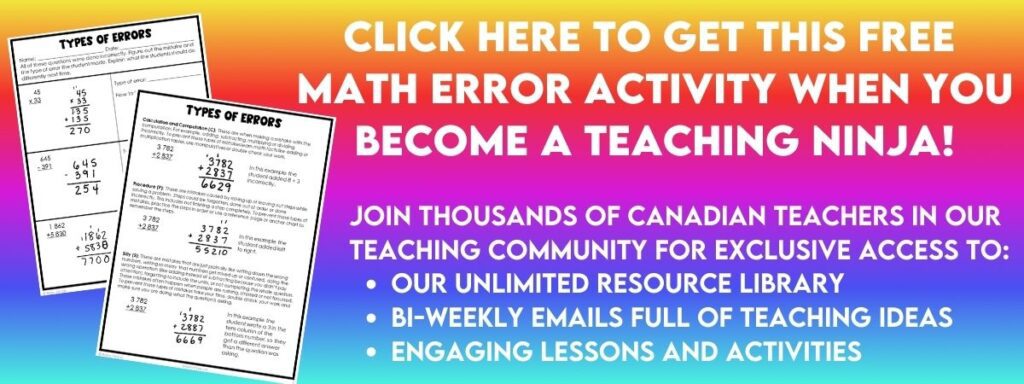
Electronic Money
The benefits of electronic money are that you don’t have to carry it, and you always have a trail of where it was spent. The con is that sometimes it doesn’t feel like you’ve spent the money, so people tend to spend more than they intended to. Electronic money includes credit cards, debit cards, e-transfers, and gift cards.
It can be challenging to have students experience spending with electronic money. This video is not specific to Canada, but it does a great job of explaining electronic money. It is important to tell students about cards that have tap and don’t use a PIN. It also doesn’t include apps like Apple Pay.
Budgeting
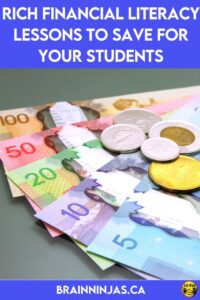
This video is a fantastic start to budgeting, and it’s a very short video just giving a general idea of what a budget is.
Some people look at a budget as restricting the amount you can spend, but a healthier view is to think about HOW you spend. People who use and stick to a budget are more likely to reach long-term money goals.
Using a budget means making the money you have spread over your needs first. If there’s not enough money, you either have to earn more or spend less to keep the budget balanced. Only about half of Canadians actually use and stick to a budget.
The Price of Life is a resource we use year after year because students love it. It helps students understand the addition and subtraction of decimals to the hundredths place, but it also makes a great budgeting activity. Find The Price of Life on TpT ($USD) and our BN Shop ($CAN).
We also have a similar resource where students will need to multiply and divide to figure out costs for a Monster Field Trip. It is another way to practice budgeting. Find Monster Field Trip on TpT ($USD) and our BN Shop ($CAN).
Saving
When we talk about saving, there are two distinct ways to think about it.
The first is saving money for another use. This can be short-term savings or planned spending (like saving for a purchase). It could also be long-term saving (like saving for retirement). This type of saving is about putting money aside and not spending it on other things.
Another way to think about saving is by spending less on items. We think of this type of saving as getting a purchase on sale. This means understanding the unit price of an item or the percentage discount.
Retailers use psychological tactics to make people think they are getting a better deal or to feel pressured into making a purchase. Everything from the colours and fonts used on a price tag to the music played in a store is carefully crafted to separate consumers (buyers) from their money.
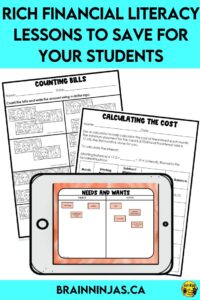
Unit Prices
It is important that students understand how to find the unit price of an item so they can determine the best price. If you search online for an online grocery flier, you can find lots of numbers that you can use for this activity.
Have students pick an item in the flier where there are individual units within a price. For example, a 24-pack of toilet paper. Divide the price by 24 to get the unit price. If another student in the class can find toilet paper at a different store, you can compare the prices to find the best deal.
Percentage Discounts
People often think that the bigger the percentage discount, the better the deal, but this isn’t always the case. It’s important to first figure out the discount and then figure out the unit price to see if it’s actually a good deal. Sometimes, the sale price of one item is more expensive than the same or similar product elsewhere.
Give your students the challenge to find the best deal for a specific item using online fliers. These can be for groceries or electronics, video games, cars or anything else you can find prices for.
Calculating Percentage Discounts is a set of worksheets available on TpT ($USD) and our BN Shop ($CAN).
Investing
Investing is the process of planning ways to make your money grow. It takes lots of research, and it is the one place where most people lose their money. This can be through bad advice, scams, or not doing the work to fully understand the type of investment.
In the 90s, there was a craze to buy Beanie Babies. These were little stuffed toys that only cost $5, but people went crazy for them. It was right at the beginning of the internet when eBay was starting up, and people started selling the toys online, hoping to make a profit from the rare ones.
But that started a new problem. People started scamming others with counterfeit Beanie Babies, and people decided they were done spending their money. Some people had spent thousands of dollars thinking they were going to make a fortune. But, it all crashed and very few people ever got their money back. This is an example of a bad investment. Only the first few people made any money, but everyone else was just out the money (even though they had all those stuffed toys).
Generally, the rule with investing is that if it sounds too good to be true, it’s probably a scam. Long-term investments make money over a long time.
Types of Investments
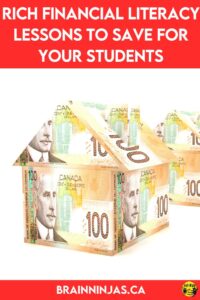
An equity investment is money that is invested in a company by purchasing shares of that company in the stock market. This is a common type of investment, but it takes lots of education to make good decisions. It is a little like gambling because there are no guarantees.
Debt investment is an investment made in a firm or project through the purchase of a large quantity of debt. The expectation is that you’ll get all your money back along with interest and earnings. An example of a debt investment is giving money to a new business and getting paid back a year later when the business starts making money.
Liquid investments are accounts that people can easily convert to cash without incurring fiscal penalties. Common liquid investments are stocks, bonds and mutual funds. They can be bought and sold throughout the trading day. Generally, these are common investments that people make when they have money to invest.
Other investments include things like precious metals, collectibles, real estate (like a house), and cryptocurrency. These investments can be tricky because they can fluctuate. The Beanie Babies collapse is an example of a collectible investment. If you own a Wayne Gretzky rookie hockey card, that would be another (and probably much more profitable) example. Collectibles are generally only as valuable as the person willing to buy them.
Considering Risk
When people make decisions about investments, it is important to think about the amount of money that is willing to be lost. This is called a risk assessment. The more money you are willing to lose, the more risk you are willing to take and, therefore, could result in a bigger payout (or loss). If you have a small amount of money or less time to earn more, you want to lower your risk and invest in safer options.
Looking for Detailed Financial Literacy Lesson Plans?
Our financial literacy unit plans come with complete lesson plans, student pages, and answer keys. All the student pages have digital versions, so you can differentiate easily or reduce your printing costs. The units are also included in our Full Year Health and Wellness Lessons Bundle. If you are looking for all our other health units, check out this post: You Need to Stop Overlooking Health Class!
Financial Literacy Unit for Grades 1-3 is available on TpT ($USD) and our BN Shop ($CAN).
Full Year of Health and Wellness Lessons Bundle for Grades 1-3 is available on TpT ($USD) and our BN Shop ($CAN).
Financial Literacy Unit for Grades 4-6 is available on TpT ($USD) and our BN Shop ($CAN).
Full Year of Health and Wellness Lessons Bundle for Grades 4-6 is available on TpT ($USD) and our BN Shop ($CAN).
What about you?
Is there a financial literacy lesson that still baffles you? Tell us about it in the comments below.






